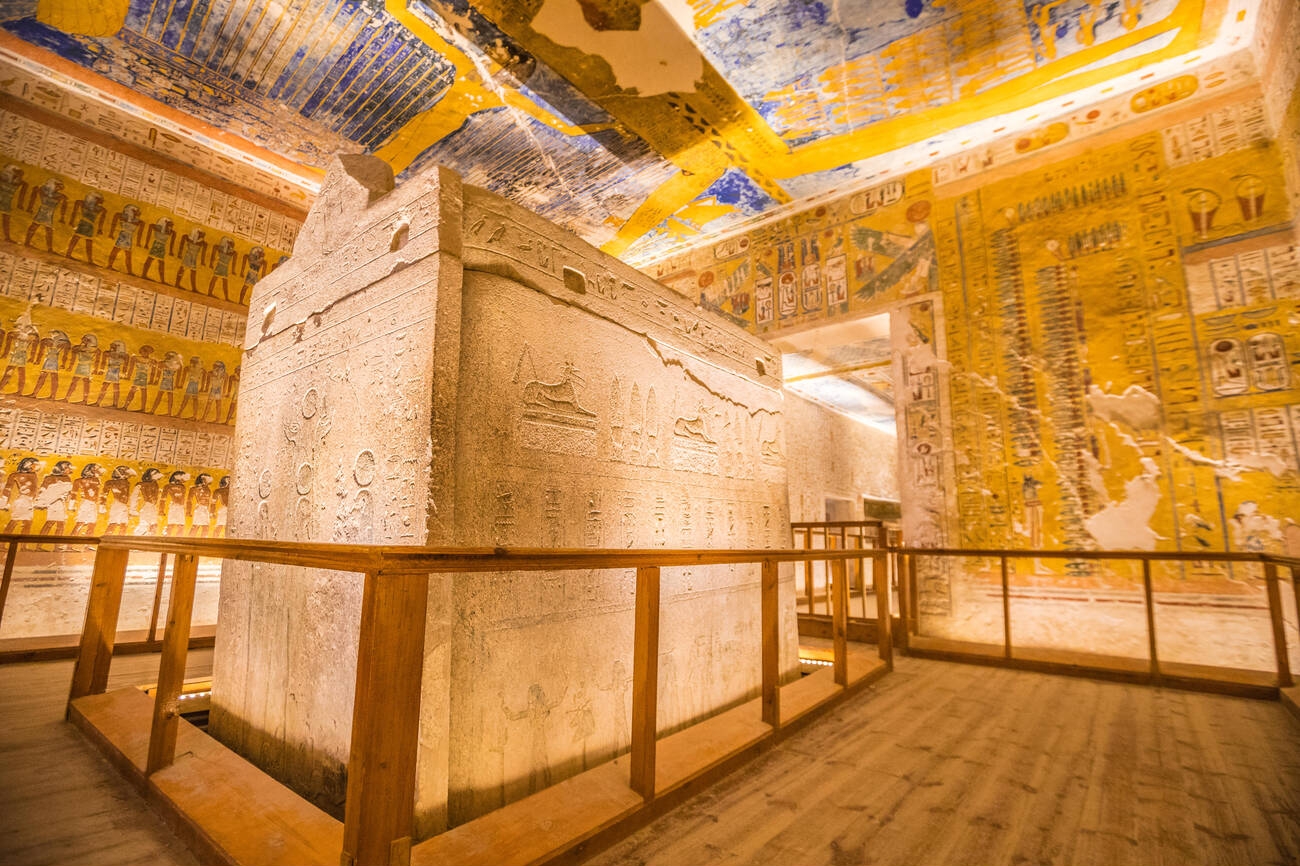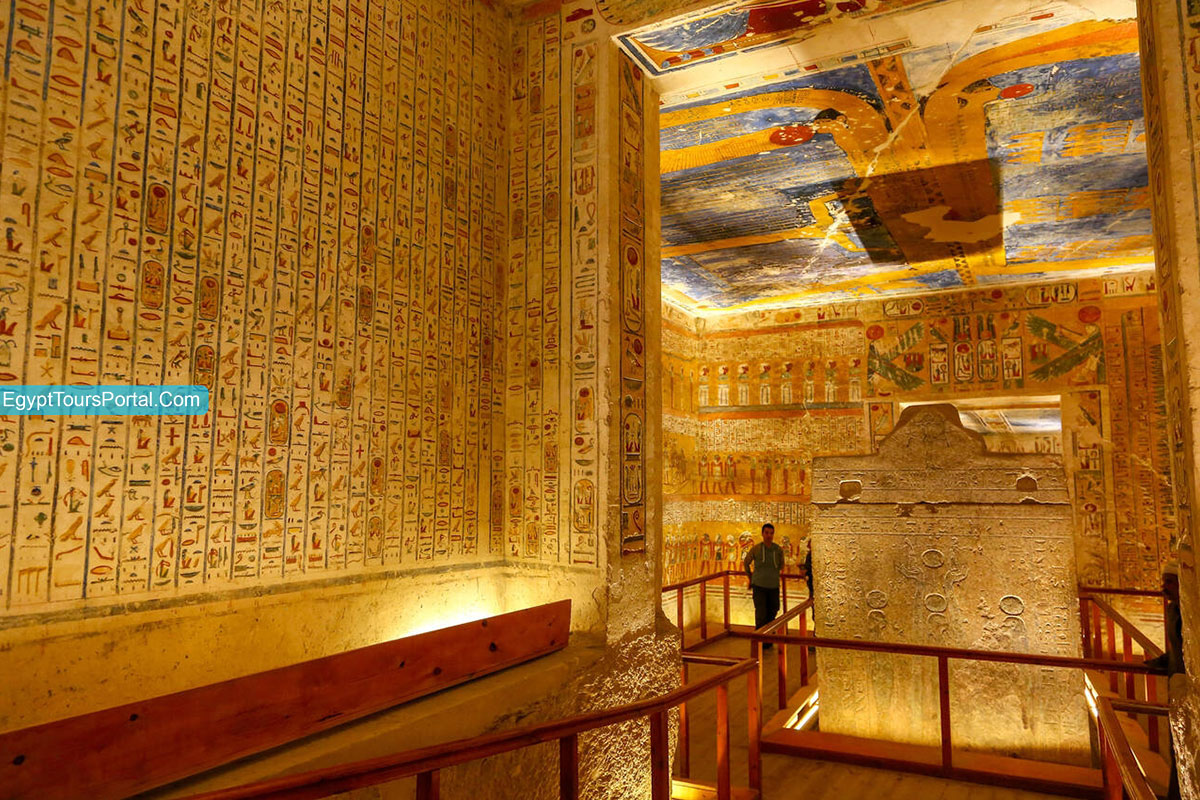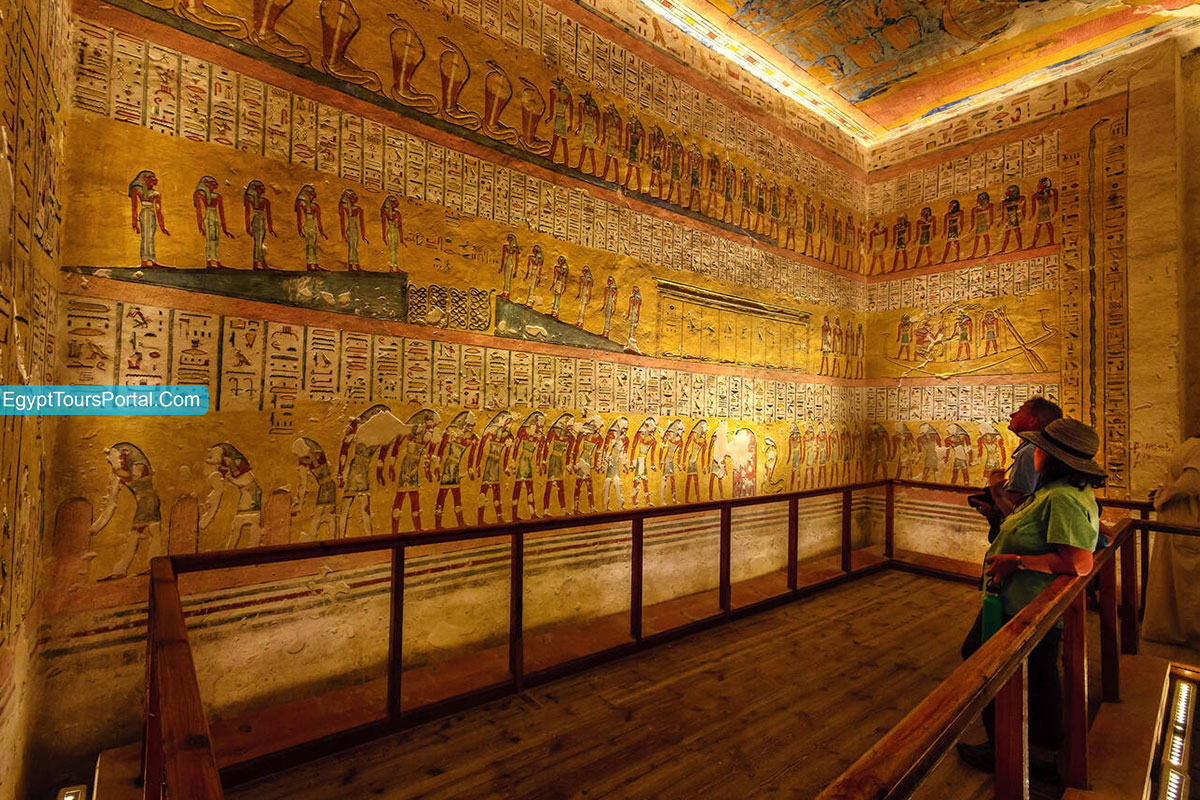Explore the Tomb of Ramses IV in Egypt's Valley of the Kings, a pivotal archaeological site from the New Kingdom. Discover its historical significance, architectural marvels, and artistic richness, including vibrant wall paintings and religious texts.

The Tomb of Ramses IV, located in the Valley of the Kings in Luxor, Egypt, is a significant ancient Egyptian burial site. This tomb, designated as KV2, is part of a larger necropolis that served as the final resting place for pharaohs and powerful nobles of the New Kingdom period of ancient Egypt. Ramses IV, who reigned during the 20th Dynasty, commissioned this tomb, which reflects the grandeur and intricacies of Egyptian burial practices. The tomb's architecture and art are exemplary of the period's style, featuring vibrant wall paintings and inscriptions from religious texts. These artistic elements provide insights into the beliefs and funerary rituals of ancient Egypt. The Tomb of Ramses IV continues to be an important site for archaeological studies and attracts scholars and tourists alike, drawn by its historical significance and artistic beauty.
This article explores the Tomb of Ramses IV, showcasing its architectural splendor and artistic richness while illuminating the ancient Egyptian beliefs and practices surrounding death and the afterlife.

The tomb of Ramses IV was first discovered by Edward Ayrton between 1905 and 1906, and then it was excavated again in 1920. Various materials like wood, Shabtis, Ostraca, faience, and glass were found inside the tomb. The tomb of Ramses IV "KV2" is located at the base of the hill on the northwest side of the Valley of the Kings. KV2 is highly famous and unique in various ways, as it contains a great deal of graffiti.
Delve into the history of the Valley of the Kings with information on its tombs, maps, and key facts. Discover more now.
Read MoreThe tomb is in very good condition as it was used as a hotel by early Egyptologists like Champollion, Theodore Davis, Robert Hay, and others while excavating the Valley of the Kings. Ramses IV's tomb was used as a residence for Coptic Christians. The tomb walls display 656 individual graffiti left by a large amount of Coptic and Greek visitors.

King Ramesses IV was the 3rd pharaoh of the 20th Dynasty of Ancient Egypt, the second son of Ramesses III, and his mother was Tyti. He was born in 1176 BC and died in 1149 BC at the age of 27. His promotion to crown prince was suggested by his appearance in a festival scene at the Ramesses III temple. Despite his father's 31-year reign, Ramesses IV became pharaoh at 21 and ruled from 1155 to 1149 BC. His burial chamber is called KV2 in the Valley of the Kings. His most incredible and renowned monument is the Temple of Khonsu at Karnak Temples complex. As crown prince, he held titles like "Royal scribe," "Hereditary Prince" and "Generalissimo". Ramesses IV's reign was succeeded by his son, Ramesses V, at the age of 13.
Ruler Ramesses IV embarked on a grand building initiative that mirrors the monumental projects of Ramesses II. This included expanding the workforce at Deir el-Medina and organizing multiple expeditions to quarries and mines across Egypt. The largest venture involved over 8,000 men, including soldiers, temple personnel, and laborers, led by the High Ramessesnakht "Priest of Amun". Ramesses IV concentrated on enlarging his father's Temple of Khonsu at Karnak and erecting a sizable mortuary temple near the Temple of Hatshepsut. He dispatched multiple expeditions to the Sinai's turquoise mines, with documented missions by a trusted official named Sobekhotep and a senior army scribe named Panufer. The latter expedition's purpose was to acquire turquoise and establish a chapel honoring Ramesses IV at the Hathor temple in Serabit el-Khadim. His reign lasted for about six and a half years, and he was buried in the Valley of the Kings. His mummy was relocated from the Museum of Egyptian Antiquities to the National Museum of Egyptian Civilization in April 2021, where 17 Kings and four Queen mummies were moved in the Pharaohs' Golden Parade.

The architectural layout of the Tomb is a remarkable example of ancient Egyptian tomb design during the New Kingdom period. The tomb, known as KV2, follows a straight axis, a common feature in 20th Dynasty royal tombs. It begins with a descending entranceway that leads into a series of three successive corridors. These corridors are decorated with religious texts and iconography, including excerpts from the Book of Gates and the Book of Caverns, reflecting the journey of the pharaoh through the underworld.
Following these corridors, there is a well chamber, which was traditionally believed to protect the tomb against intruders and floodwaters. However, in the case of Ramses IV’s tomb, this chamber was left unfinished and undecorated.
Read the most important facts about the Valley of the Queens, know the most famous tombs inside the Valley of the Queens, and more...
Read MoreBeyond the well chamber lies a pillared hall leading into the burial chamber. This chamber is significant for its size and the detailed astronomical ceiling, depicting the goddess Nut. The burial chamber also housed the sarcophagus of Ramses IV, a massive red granite piece that remains in situ.
Adjacent to the burial chamber are small annexes, which were intended for storing funerary goods and offerings. The entire layout of the tomb, with its straight axis and specific chambers, was designed to facilitate the pharaoh's journey to the afterlife, a journey deeply embedded in the religious and cultural beliefs of ancient Egypt.

Most of the decorations are intact, totally enchanting, and able to reveal the use of several artistic elements and how they are created and used. The first two passages of the tomb have scenes from the litany of Ra, and the third scene of the tomb is the Book of Caverns, while the anteroom is decorated with images of the Book of the Dead. The walls of the tomb hold parts of the Book of Gates, books of the Heavens, and the Amduat.
The sarcophagus of the pharaoh Ramses IV is broken at one end, the lid is missing, and the mummy is removed. The tomb's façade is decorated with images and illustrations depicting the king's coronation with the pictures of Isis and Nephyths venerating the sun disk; the ceilings have pictures of winged scarabs with spread wings, vultures, and falcons.
The Valley of the Kings is filled with pure magic and allure, which enchant any person who comes across it. The ancient lands of Luxor and Aswan are calling your name, so don't miss this chance to be among living miracles by booking one of our Egypt tour packages or Nile river cruise to witness the amazing tombs of ancient Pharaohs at the Valley of the Kings plus explore the ancient places such as Giza pyramids, the Sphinx, Karnak & Hatshepsut temples, the great temples of Abu Simbel, and much more.
Private 4 Days Cairo Tour Packages for Irish Travelers 4 days Cairo Egypt Tour packa...
Tour Location: Cairo – Giza...
5 Days Cairo and Alexandria Tour Package For Irish Travelers 5 days Cairo and Alexan...
Tour Location: Cairo/Giza/Alexandria...
6 Days Cairo, Luxor & Aswan Tour Package For Irish Travelers 6 days Cairo, Luxor...
Tour Location: Cairo/Giza/Aswan/Luxor...
Amazing 7 Days Cairo and Hurghada Holiday for Irish Travelers 7 Days Cairo & Hur...
Tour Location: Cairo – Giza – Hurgh...
The tomb of Ramesses IV which is known as KV2 in the Valley of the Kings, dates back to the New Kingdom around 1153 BC to serve as the final resting place for Ramesses IV, who reigned as pharaoh from 1155 to 1149 BC. The tomb is roughly 3,100 years old and originated from the 20th dynasty of Egypt
The entire country of Egypt deserve to be explored with its every heavenly detail but there are places that must be seen before any other such as the breathtaking Hurghada's red sea, The wonders of Cairo the pyramids of Giza, the great sphinx, the Egyptian Museum, Khan El Khalili Bazaar, the wonders of Luxor like Valley of the Kings, Karnak & Hatshepsut temple and the wonders of Aswan such as Abu Simbel temples, Philea temple, Unfinished obelisk and The Wonders of Alexandria like Qaitbat Citadel, Pompey's Pillar and Alexandria Library. Read more about the best places to visit in Egypt.
If you want to apply for a Visa On Arrival that lasts for 30 days then you should be one of the eligible countries, have a valid passport with at least 6 months remaining and pay 25$ USD in cash, as for the E-Visa for 30 day you should have a valid passport for at least 8 months, complete the online application, pay the e-visa fee then print the e-visa to later be presented to the airport border guard. You could also be one of the lucky ones who can obtain a free visa for 90 days. Read more about Egypt travel visa.
Egypt has a variety of delicious cuisines but we recommend “Ful & Ta’meya (Fava Beans and Falafel)”, Mulukhiya, “Koshary”, a traditional Egyptian pasta dish, and Kebab & Kofta, the Egyptian traditional meat dish.
The best time to travel to Egypt is during the winter from September to April as the climate becomes a little tropical accompanied by a magical atmosphere of warm weather with a winter breeze. You will be notified in the week of your trip if the Climate is unsafe and if any changes have been made.
You should pack everything you could ever need in a small bag so you could move easily between your destinations.
We have been creating the finest vacations for more than 20 years around the most majestic destinations in Egypt. Our staff consists of the best operators, guides and drivers who dedicate all of their time & effort to make you have the perfect vacation. All of our tours are customized by Travel, Financial & Time consultants to fit your every possible need during your vacation. It doesn't go without saying that your safety and comfort are our main priority and all of our resources will be directed to provide the finest atmosphere until you return home.
You will feel safe in Egypt as the current atmosphere of the country is quite peaceful after the government took powerful measures like restructuring the entire tourist police to include all the important and tourist attractions in Egypt. Read more about is it safe to travel to Egypt.
Wear whatever feels right and comfortable. It is advised to wear something light and comfortable footwear like a closed-toe shoe to sustain the terrain of Egypt. Put on sun block during your time in Egypt in the summer to protect yourself from the sun.
The best activity is by far boarding a Nile Cruise between Luxor and Aswan or Vise Versa. Witness the beauty of Egypt from a hot balloon or a plane and try all the delicious Egyptian cuisines and drinks plus shopping in old Cairo. Explore the allure and wonders of the red sea in the magical city resorts of Egypt like Hurghada and many more by diving and snorkeling in the marine life or Hurghada. Behold the mesmerizing western desert by a safari trip under the heavenly Egyptian skies.
There are a lot of public holidays in Egypt too many to count either religious or nation, the most important festivals are the holy month of Ramadan which ends with Eid Al Fitr, Christmas and new years eve. Read more about festivals & publich holidays in Egypt.
Egypt is considered to be one of the most liberal Islamic countries but it has become a little bit conservative in the last couple of decades so it is advised to avoid showing your chest, shoulders or legs below the knees.
Arabic is the official language and Most Egyptians, who live in the cities, speak or understand English or at least some English words or phrases. Fewer Egyptians can speak French, Italian, Spanish, and German. Professional tour guides, who work in the tourism sector, are equipped to handle visitors who cannot speak Arabic and they will speak enough English and other languages to fulfill the needs of all our clients.
The fastest way is a car, of course, a taxi. If you are in Cairo ride a white taxi to move faster or you could board the fastest way of transportation in Egypt metro if the roads are in rush hour.
The temperature in Egypt ranges from 37c to 14 c. Summer in Egypt is somehow hot but sometimes it becomes cold at night and winter is cool and mild. The average of low temperatures vary from 9.5 °C in the wintertime to 23 °C in the summertime and the average high temperatures vary from 17 °C in the wintertime to 32 °C in the summertime. The temperature is moderate all along the coasts.
It is the home of everything a traveler might be looking for from amazing historical sites dating to more than 4000 years to enchanting city resorts & beaches. You will live the vacation you deserve as Egypt has everything you could possibly imagine.









